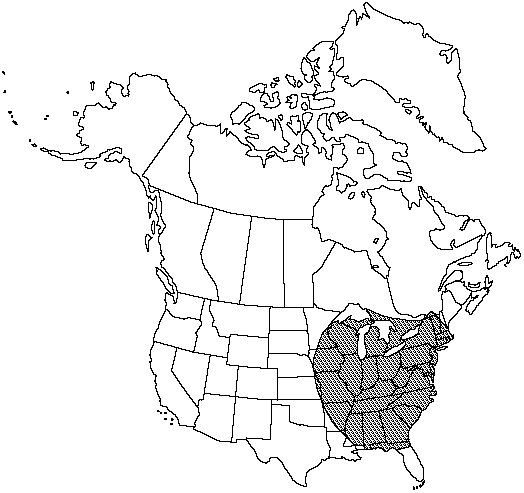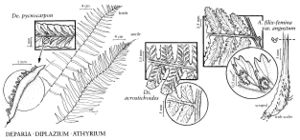Difference between revisions of "Diplazium pycnocarpon"
Index N. Amer. Ferns 60. 1938.
FNA>Volume Importer |
FNA>Volume Importer |
||
| Line 26: | Line 26: | ||
}}<!-- | }}<!-- | ||
| − | --><span class="statement" id="st- | + | --><span class="statement" id="st-undefined" data-properties=""><b>Stems </b>creeping; scales brown, broadly lanceolate, margins entire. <b>Petiole</b> 15–40(–50) cm. <b>Blade</b> oblong-lanceolate, 1-pinnate, 30–75 × 8–25 cm, ± narrowed to base with reduced proximal pinnae, broadest above base, abruptly acuminate to apex. <b>Pinnae</b> linear, ± entire to shallowly crenulate, base truncate or acroscopically auriculate, apex acuminate. <b>Veins</b> usually 1–2-forked, nearly reaching sinuses between crenations. <b>Sori</b> elongate, straight or slightly falcate, single or rarely double; indusia vaulted, ± thick. <b>2n</b> = 80.</span><!-- |
-->{{Treatment/Body | -->{{Treatment/Body | ||
| Line 55: | Line 55: | ||
|publication year=1938 | |publication year=1938 | ||
|special status= | |special status= | ||
| − | |source xml=https://jpend@bitbucket.org/aafc-mbb/fna- | + | |source xml=https://jpend@bitbucket.org/aafc-mbb/fna-data-curation.git/src/9216fc802291cd3df363fd52122300479582ede7/coarse_grained_fna_xml/V2/V2_503.xml |
|genus=Diplazium | |genus=Diplazium | ||
|species=Diplazium pycnocarpon | |species=Diplazium pycnocarpon | ||
| − | |||
| − | |||
| − | |||
| − | |||
| − | |||
| − | |||
| − | |||
| − | |||
| − | |||
| − | |||
| − | |||
| − | |||
| − | |||
| − | |||
| − | |||
| − | |||
| − | |||
| − | |||
| − | |||
| − | |||
| − | |||
}}<!-- | }}<!-- | ||
-->[[Category:Treatment]][[Category:Diplazium]] | -->[[Category:Treatment]][[Category:Diplazium]] | ||
Revision as of 13:22, 27 July 2019
Stems creeping; scales brown, broadly lanceolate, margins entire. Petiole 15–40(–50) cm. Blade oblong-lanceolate, 1-pinnate, 30–75 × 8–25 cm, ± narrowed to base with reduced proximal pinnae, broadest above base, abruptly acuminate to apex. Pinnae linear, ± entire to shallowly crenulate, base truncate or acroscopically auriculate, apex acuminate. Veins usually 1–2-forked, nearly reaching sinuses between crenations. Sori elongate, straight or slightly falcate, single or rarely double; indusia vaulted, ± thick. 2n = 80.
Habitat: Moist woods and slopes in neutral soil
Elevation: 150–1000 m
Distribution

Ont., Que., Ala., Ark., Conn., Del., D.C., Fla., Ga., Ill., Ind., Iowa, Kans., Ky., La., Md., Mass., Mich., Minn., Miss., Mo., N.H., N.J., N.Y., N.C., Ohio, Pa., R.I., S.C., Tenn., Vt., Va., W.Va., Wis.
Discussion
Diplazium pycnocarpon has commonly been placed in Athyrium, but it is closely related to the east Malesian Diplazium flavoviride Alston (M. Kato and D. Darnaedi 1988).
Selected References
None.
